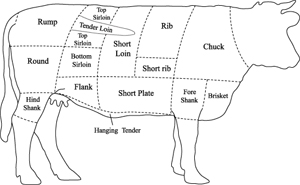- Home
- About Us
- Contact Us
- Your Gift Card: Activate
- Check Card Balance
- Your Shopping Cart
 There's nothing like a juicy steak cooked to perfection or a slice of roast beef with potatoes and gravy. As one of the most popular meats to eat, Aussies really love their beef. Yet when it comes to choosing a cut at the supermarket or from your local butcher, knowing which one has the best flavour can be confusing. The truth is that the best cut will depend a lot on how you want to cook it.
There's nothing like a juicy steak cooked to perfection or a slice of roast beef with potatoes and gravy. As one of the most popular meats to eat, Aussies really love their beef. Yet when it comes to choosing a cut at the supermarket or from your local butcher, knowing which one has the best flavour can be confusing. The truth is that the best cut will depend a lot on how you want to cook it.
In general, you want to select a piece of beef that's a dark red colour. It should smell meaty, but not sour. If there is any fat on the cut it should feel firm and waxy, and be a creamy white colour. To pick the right cut of beef for what you're planning to cook, take a look at our guide.
Taken from the rump area, the rump cap or rostbif are the cuts you want to look out for. Some cultures consider this part of the animal the best because of the incredible flavour you get in these cuts. A rump cut can be roasted whole in the oven or sliced across the grain for a nice steak.
Apart from a rump steak, the best cuts for barbecuing or pan frying are the tenderloin and the t-bone steak. The tenderloin sits near the spine of the animal and is a muscle that's not used too much. It's also one of the cuts that has the least amount of connective tissue. A tenderloin fillet is tender and juicy making it perfect to grill or pan fry with a simple seasoning of salt and pepper. An Aussie classic, the t-bone steak is a slice from the sirloin area and the meat comes with a t-shaped bone. The cut is great for throwing on the barbecue.
When whipping up a beef stir fry you want thin strips of meat that cook quickly and aren't too tough or chewy. A cut like a scotch fillet steak is ideal. Like the tenderloin, the meat comes from a muscle that's not often put to work. As such it is incredibly tender and is suited to high heat cooking methods like that involved in stir frying.
When making stews, curries or casseroles you want to be using a cut of beef that can stand the long cooking process without becoming too tough or overcooked. Meat with a lot of connective tissue work well because the slow, moist technique involved breaks a lot of this tissue down. Chuck steak, taken from the neck area, is a good to use when roughly diced. Point end brisket is also ideal, and the meat will naturally fall apart into shreds as you slow cook it.